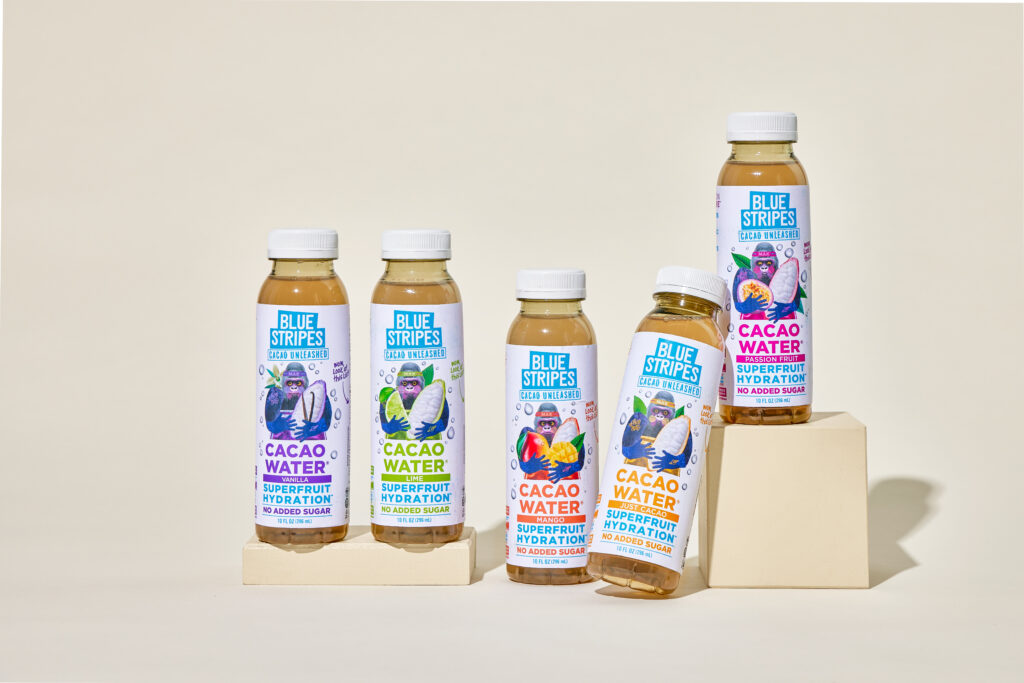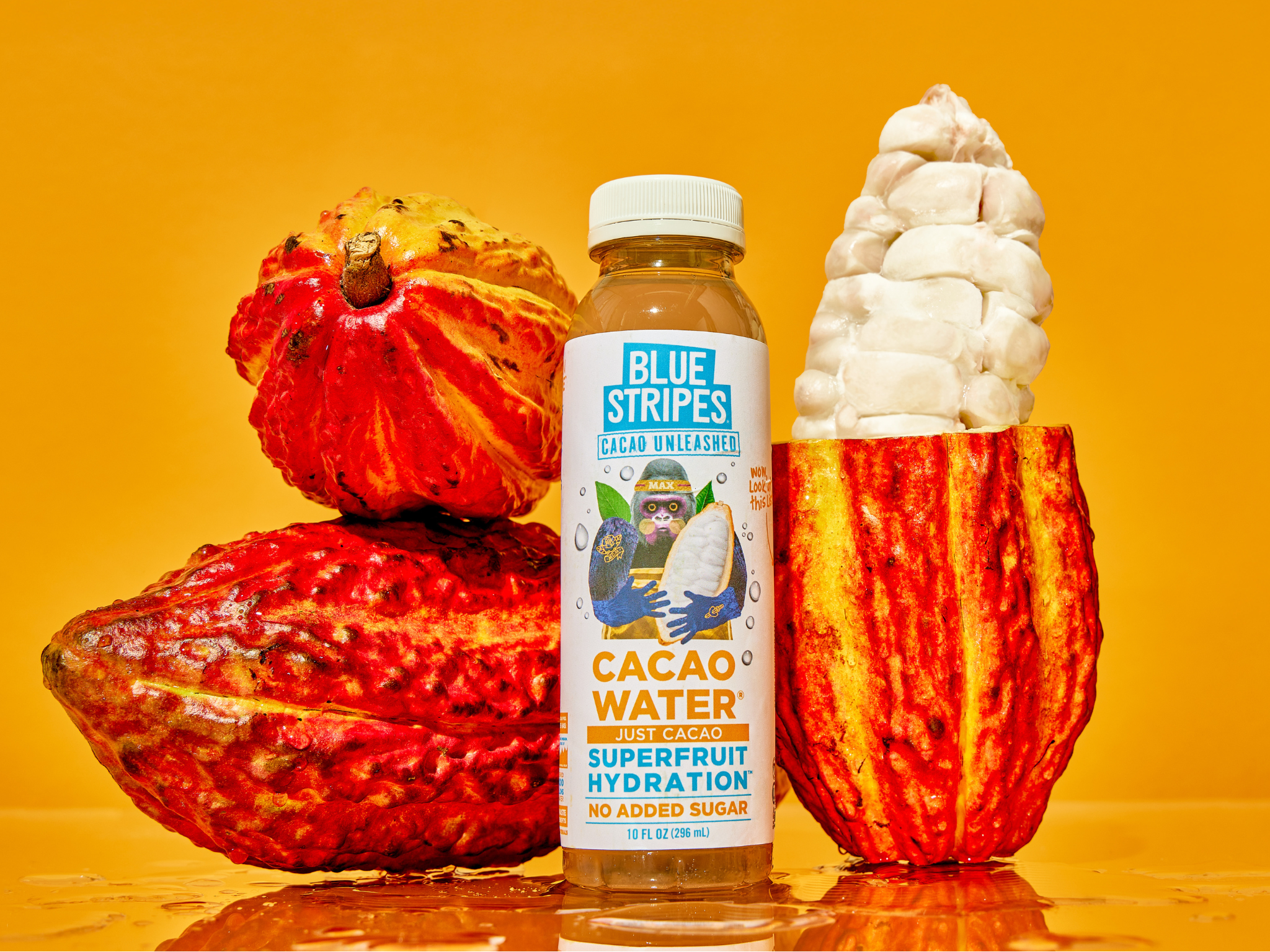Hershey’s, Nick DiGiovanni Part of $20M Investment for Startup Making Upcycled Cacao Products
5 Mins Read
US cacao startup Blue Stripes has closed a $20M Series B investment round to develop superfood chocolates, with backers including Hershey’s and celebrity chef Nick DiGiovanni.
New York-based Blue Stripes, which tackles chocolate industry waste by upcycling the cacao fruit, has secured $20M in a Series B round led by Zintinus.
Additional investors include The Hershey Company, Whole Foods Market, DMG Ventures, Hamilton Lane, and Praesidium, while YouTuber and celebrity chef Nick DiGiovanni has also come on board as an equity partner and brand ambassador.
“His support is authentic, and as passionate supporters of the brand, we believe this partnership will build more organic recognition,” Blue Stripes co-founder and CEO Oded Brenner tells Green Queen. He calls DiGiovanni “instrumental in increasing brand awareness”.
“I’ve known Oded for many years and have always described him to others as the ‘modern-day Willy Wonka’,” says DiGiovanni. “Over the years I’ve learned so much about the cacao industry, so I’m excited to be a part of the Blue Stripes team to show the world that cacao is so much more than just chocolate.”
Brenner adds that the partnership with the YouTuber is just the beginning. “Our focus is on real and meaningful connections with advocates who understand our mission.”
Every step of Blue Stripes’s cacao production happens on farms
Brenner is an industry veteran who founded the global chocolate brand Max Brenner in 1996. He established Blue Stripes with co-founder Aviv Schwietzer to champion cacao fruit as an ingredient and address the industry’s massive waste problem. The company stood out from the natural and wellness foods crowd with its whimsical branding.
Blue Stripes is aiming to greenify one of the world’s most wasted fruit, which is also responsible for a highly polluting industry. Cocoa production has driven deforestation in key producing countries – in Ivory Coast (the largest cacao grower), over 85% of forest area has been lost since 1960.
Cocoa beans, meanwhile, have one of the highest carbon opportunity costs – the amount of carbon lost from native vegetation and soils to produce food – of any crop. And an estimated 70% of the cacao fruit that these beans come from is wasted during cocoa production.
So by using something that’s usually thrown away, Blue Stripes says it creates an income increase for cocoa farmers and enhances the value of the crop. It sources and processes the ingredient in Ecuador, where cacao pods are harvested directly from the farms.
“Once the pods are brought to our processing centre, they are cleaned, opened, and the pulp is carefully removed. The pulp is then cold-pressed and bottled right in Ecuador,” explains Brenner. “Every step of the process, from harvesting to packaging, takes place within the farms which ensures efficiency and minimizes environmental impact, especially in terms of transportation. By processing the cacao where it is grown, we not only maximise the use of the entire fruit, but also reduce our ecological footprint.”
While cacao and its products have an outsized impact on the planet, the crop itself is under threat from the changing climate, with a third of all cocoa trees facing the threat of extinction by 2050. “Cacao is a vulnerable crop, especially with the growing threat of climate change, which has already resulted in significant losses. Last year, weather conditions and disease caused 50% of the crop to fail,” says Brenner.
“Yet, by utilising the whole fruit and reducing waste, we are mitigating environmental impact and enhancing sustainability. Even with decreased yields, the remaining fruit can still be maximised for production. As we create greater demand for whole cacao products, it encourages farmers to invest in planting more trees, helping secure the future of the crop despite its vulnerability.”
Blue Stripes to create ‘entirely new’ superfood chocolate category

Among Blue Stripes’s line of upcycled cocoa products are its cacao water, whole-cacao granola, trail mix, and chocolate, dried cacao fruit, as well as chocolate-covered cacao beans. They’re available nationwide via its website and Amazon, but also at Whole Foods Market, Fresh Market, Sprouts, and other premium retailers like Happier Grocery.
The investment round comes during a year when cacao prices have reached record highs, thanks in large part to disrupted yields as a result of climate change. How does Blue Stripes aim to position its products in a world where cost-of-living is a major factor for consumers?
“We don’t see ourselves as a premium brand. However, our goal is to scale and make the new uses for the cacao fruit that we’ve created more mainstream, which will allow us to reduce prices over time,” says Brenner.
“Currently, within the natural and refrigerated markets, our Cacao Water is one of the most affordable options. Scaling will help us bring the benefits of cacao to more people and will create opportunities for other brands who want to leverage the entire cacao fruit.”
He suggests that the fresh capital would enable the company to “advance its whole cacao process technologies, develop new products, increase distribution, and raise consumer awareness” about cacao’s benefits as a superfood – the fruit contains flavonoids and regulates blood pressure, prevents clots and, enhances blood flow to the brain and heart.
In that vein, Blue Stripes is now looking to develop “an entirely new category” within the chocolate industry by tapping into cacao’s superfood credentials. These products would be rich in antioxidants, minerals, and fibre – an increasingly important move in the GLP-1 era.
He confirms that Hershey’s participation in the round is not a precursor for joint product development: “Hershey’s involvement is purely as investors who recognise and believe in building a more sustainable future for the chocolate industry.”
Aside from Blue Stripes, Cabosse Naturals, CaPao, Koa and Pacha de Cacao are also innovating with the cacao fruit. Several startups are also working to reduce the chocolate industry’s climate footprint. Some are growing it in labs using cocoa cells, like Celleste Bio, Kokomodo and California Cultured, while others – such as Win-Win, Foreverland, Planet A Foods, Voyage Foods, and Nukoko – are making cocoa-free versions of chocolate with other ingredients.
“While we’re aware of the trend toward lab-grown or cocoa-free alternatives, they tend to be more expensive and don’t compare to the real product,” says Brenner. “Our focus remains on natural, clean, and minimally processed cacao. Our commitment is from tree to shelf, ensuring our products maintain their core values of purity and sustainability.”



